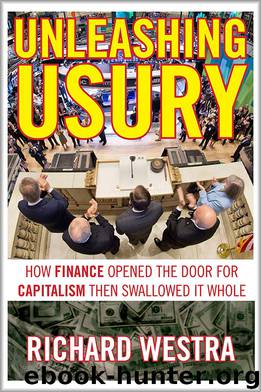Unleashing Usury by Richard Westra

Author:Richard Westra
Language: eng
Format: epub
ISBN: 9780997287004
Publisher: SCB Distributors
The Use Value Ultimatum
The story of the Great Depression is replete with proximate causes. The fallout from WWI certainly figures prominently as one. Economist Michael Hudson, in his landmark book, Super Imperialism, offers the clearest explanation.38 According to him, US financing of its European Allies in the WWI period left a festering sore at the heart of the global financial system. Twin veins of this “sore” were the transposition of international finance from a regime dominated by private flows to one of intergovernmental finance: and the rise of the US as a global creditor state. The former saw Allied states debt expanded in a way which wildly exceeded the productive resources of the continent. Such would not have occurred under the suzerainty of private lenders who would have exercised greater prudence in lending given their private exposure to potential default (given lending conditions of the time, of course). European debt was problematic under conditions of ramped up US trade protectionism. This meant there was no chance that European debtors might be able to at least partially export their way out of debt travails.
Nevertheless, a peculiar “triangular flow of payments” was instigated, argues Hudson, which brought private lending back in to support Europe in its irredeemably indebted time of need. Billions of dollars were lent to Germany (as asset after asset in Germany was placed on the auction block) which it then used to pay war reparations to Allies, who then used the money to service their debt to the US government. Bracketing here the question of the complete lack of long term sustainability of such an arrangement in itself, from 1928 private flows turned away from Europe to booming US stock markets. US investors were soon followed by European and other investors attracted by the Wall Street bonanza which in turn led to a contraction of credit elsewhere in the world, impelling other economies into recession. The dearth of global liquidity and spreading recession around the world soon exacerbated the travails of the US economy.
The empirical evidence here is compelling. The Dow Jones Industrial Average (DJIA) leaped from 191 in the beginning of 1928 to 381 by September 1929. This doubling of equity prices dwarfed potential returns from US investments overseas where capital had previously flowed. Simultaneously, the net outflow from the US of $900 million in 1927-28 became but an annual trickle of $86 million from 1929 to 1931.39
What were the “travails” of the US economy? The prima facie case is that it had much to do with exuberance over Wall Street stock market opportunity. Mass public information about the security of stock investments lagged behind the widespread acquisition of “common stock” holdings. Individuals owning common shares numbered a half million in 1900. By 1930 that number had multiplied to 10 million.40 There was also the issue of rising consumer debt. From the early 20th century a raft of consumer goods became available in the advanced economies. Personal incomes had doubled in these economies between 1870 and 1913. Demand
Download
This site does not store any files on its server. We only index and link to content provided by other sites. Please contact the content providers to delete copyright contents if any and email us, we'll remove relevant links or contents immediately.
International Integration of the Brazilian Economy by Elias C. Grivoyannis(74848)
The Radium Girls by Kate Moore(11621)
Turbulence by E. J. Noyes(7700)
Nudge - Improving Decisions about Health, Wealth, and Happiness by Thaler Sunstein(7242)
The Black Swan by Nassim Nicholas Taleb(6764)
Rich Dad Poor Dad by Robert T. Kiyosaki(6176)
Pioneering Portfolio Management by David F. Swensen(6079)
Man-made Catastrophes and Risk Information Concealment by Dmitry Chernov & Didier Sornette(5647)
Zero to One by Peter Thiel(5489)
Secrecy World by Jake Bernstein(4388)
Millionaire: The Philanderer, Gambler, and Duelist Who Invented Modern Finance by Janet Gleeson(4094)
The Age of Surveillance Capitalism by Shoshana Zuboff(3985)
Skin in the Game by Nassim Nicholas Taleb(3965)
The Money Culture by Michael Lewis(3847)
Bullshit Jobs by David Graeber(3831)
Skin in the Game: Hidden Asymmetries in Daily Life by Nassim Nicholas Taleb(3723)
The Dhandho Investor by Mohnish Pabrai(3560)
The Wisdom of Finance by Mihir Desai(3524)
Blockchain Basics by Daniel Drescher(3329)
